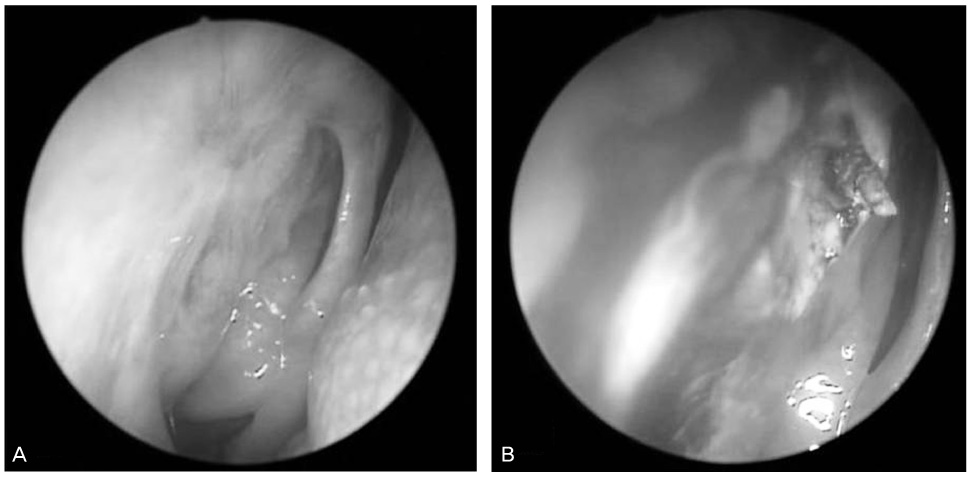J Korean Ophthalmol Soc.
2012 Apr;53(4):493-498.
The Effects of Transcanalicular Diode Laser-Assisted Revision Surgery for Failed Dacryocystorhinostomy
- Affiliations
-
- 1Department of Ophthalmology, Korea University College of Medicine, Seoul, Korea. shbaek6534@korea.ac.kr
- 2The Cheonan Kim's Eye Clinic, Cheonan, Korea.
- 3Department of Ophthalmology, Ulsan University Hospital, University of Ulsan College of Medicine, Ulsan, Korea.
Abstract
- PURPOSE
To determine the intranasal causes of failed dacryocystorhinostomy (DCR) and the effects of transcanalicular diode laser-assisted revision surgery.
METHODS
Twenty-four patients (29 eyes) who underwent revision surgery for a failed DCR at the Department of Ophthalmology, Ansan Hospital, Korea University between March 2009 and February 2011 were included in the present retrospective study. The intranasal causes of failed DCR, the time of symptoms such as epiphora and discharge after DCR, success rates of revision surgeries and follow-up periods were evaluated.
RESULTS
Membranous obstruction was found in 25 eyes (86.2%) and was accompanied with granuloma in 10 eyes; these were the most common causes of failed DCR. The mean time for symptom development after DCR was 14.6 months, the success rate of the first revision surgery was 82.1% and good results were obtained in 5 eyes after the second revision surgery. Recurrence developed in 2 eyes, but symptoms improved after the lateral tarsal strip procedure.
CONCLUSIONS
Membranous obstruction was the most common intranasal cause of failed DCR and transcanalicular diode laser-assisted revision surgery produced good results. Additionally, in patients with persistent epiphora following anatomically-patent revisional surgery, lacrimal pump failure due to lower eyelid laxity should be considered and corrected.
Keyword
MeSH Terms
Figure
Reference
-
1. Caldwell GW. Two new operations for obstruction of the nasal duct with preservation of the canaliculi. Am J Ophthalmol. 1893. 10:189–193.2. McDonogh M, Meiring JH. Endoscopic transnasal dacryocystorhinostomy. J Laryngol Otol. 1989. 103:585–587.3. Watkins LM, Janfaza P, Rubin PA. The evolution of endonasal dacryocystorhinostomy. Surv Ophthalmol. 2003. 48:73–84.4. Rice DH. Endoscopic intranasal dacryocystorhinostomy results in four patients. Arch Otolaryngol Head Neck Surg. 1990. 116:1061.5. Toti A. Nuovo metodo conservatore dicuraradicale dellesopourazioni croniche del saccolacrimale (dacriocistorhinostomia). Cli Moderna. 1904. 10:385–387.6. Levin PS, StormoGipson DJ. Endocanalicular laser-assisted dacryocystorhinostomy. An anatomic study. Arch Ophthalmol. 1992. 110:1488–1490.7. Athanasiov PA, Prabhakaran VC, Mannor G, et al. Transcanalicular approach to adult lacrimal duct obstruction: a review of instruments and methods. Ophthalmic Surg Lasers Imaging. 2009. 40:149–159.8. Detorakis ET, Drakonaki E, Papadaki E, et al. Watery eye following patent external DCR: an MR dacryocystography study. Orbit. 2010. 29:239–243.9. Woo KI, Moon SH, Kim YD. Transcanalicular laser-assisted revision of failed dacryocystorhinostomy. Ophthalmic Surg Lasers. 1998. 29:451–455.10. Woog JJ, Kennedy RH, Custer PL, et al. Endonasal dacryocystorhinostomy: a report by the American Academy of Ophthalmology. Ophthalmology. 2001. 108:2369–2377.11. Hong JE, Hatton MP, Leib ML, Fay AM. Endocanalicular laser dacryocystorhinostomy analysis of 118 consecutive surgeries. Ophthalmology. 2005. 112:1629–1633.12. Lee TS, Shin HH, Hwang SJ, Baek SH. The results of revisional surgery for the failed endonasal DCR. J Korean Ophthalmol Soc. 2007. 48:186–192.13. Kong YT, Kim TI, Kong BW. A report of 131 cases of endoscopic laser lacrimal surgery. Ophthalmology. 1994. 101:1793–1800.14. Lee HC, Chung WS. Success rate of endonasal dacryocystorhinostomy. J Korean Ophthalmol Soc. 1996. 37:211–218.15. Lee TS, Shin JC, Woog JJ. Woog JJ, editor. Endoscopic dacryocystorhinostomy: an Eastern perspective. Manual of Endoscopic Lacrimal and Orbital Surgery. 2004. 1st ed. Philadelphia: Butteerworth Heinemann;chap. 9.16. Zolli CL, Shannon GM. Dacryocystorhinostomy: a review of 119 cases. Ophthalmic Surg. 1982. 13:905–910.17. McLachlan DL, Shannon GM, Flanagan JC. Results of dacryocystorhinostomy: analysis of the reoperations. Ophthalmic Surg. 1980. 11:427–430.18. Jokinen K, Kärjä J. Endonasal dacryocystorhinostomy. Arch Otolaryngol. 1974. 100:41–44.19. McMurray CJ, McNab AA, Selva D. Late failure of dacryocystorhinostomy. Ophthal Plast Reconstr Surg. 2011. 27:99–101.20. Kim JM, Hong WP, Choi YJ, Kim SJ. The effect of nasal cavity abnormality related to surgical success rate of endonasal dacryocystorhinostomy. J Korean Ophthalmol Soc. 2006. 47:1233–1237.21. Kwon YA, Kim HC, Ha MS, et al. Success rates according to the shape of rhinostomy after endonasal dacryocystorhinostomy. J Korean Ophthalmol Soc. 2009. 50:14–18.22. Cannon PS, Sadiq SA. Can eyelid taping predict the benefit of a lateral tarsal strip procedure in patients with eyelid laxity and functional epiphora? Ophthal Plast Reconstr Surg. 2009. 25:194–196.23. Woog JJ, Metson R, Puliafito CA. Holmium:YAG endonasal laser dacryocystorhinostomy. Am J Ophthalmol. 1993. 116:1–10.24. Boush GA, Lemke BN, Dortzbach RK. Results of endonasal laser-assisted dacryocystorhinostomy. Ophthalmology. 1994. 101:955–959.25. Migliori ME. Endoscopic evaluation and management of the lacrimal sump syndrome. Ophthal Plast Reconstr Surg. 1997. 13:281–284.26. Yung MW, Hardman-Lea S. Analysis of the results of surgical endoscopic dacryocystorhinostomy: effect of the level of obstruction. Br J Ophthalmol. 2002. 86:792–794.27. Narioka J, Ohashi Y. Transcanalicular-endonasal semiconductor diode laser-assisted revision surgery for failed external dacryocystorhinostomy. Am J Ophthalmol. 2008. 146:60–68.28. Janda P, Sroka R, Mundweil B, et al. Comparison of thermal tissue effects induced by contact application of fiber guided laser systems. Lasers Surg Med. 2003. 33:93–101.29. Plaza G, Beteré F, Nogueira A. Transcanalicular dacryocystorhinostomy with diode laser: long-term results. Ophthal Plast Reconstr Surg. 2007. 23:179–182.
- Full Text Links
- Actions
-
Cited
- CITED
-
- Close
- Share
- Similar articles
-
- Surgical Outcomes of Endonasal Revision Surgery for Failed DCR According to Number of Silicone Tubes
- The Long-Term Results of Transcanalicular Dacryocystorhinostomy with a Diode Laser
- The Surgical Results of Transcanalicular LASER-assisted Dacryocystorhinostomy
- Endoscopic Laser Dacryocystorhinostomy
- Diode Laser Ab Externo Sclerostomy in Rabbits



